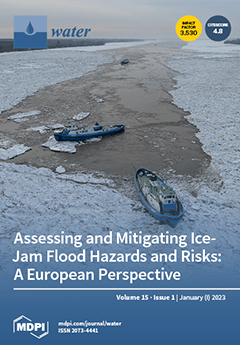The aim of this research was to evaluate the phytoremediative potential of
Epipremnum aureum and
Bacopa monnieri to improve the chemical properties of irrigation water exposed to the following two saline concentrations: highly saline (EC 2000 μS cm
−1) and severely saline
[...] Read more.
The aim of this research was to evaluate the phytoremediative potential of
Epipremnum aureum and
Bacopa monnieri to improve the chemical properties of irrigation water exposed to the following two saline concentrations: highly saline (EC 2000 μS cm
−1) and severely saline (EC 4000 μS cm
−1). The artificial wetlands used in this experiment were of the free water surface type, considering a hydraulic retention time of 42 days. The evaluated treatments were configured as follows: T1 (
B. monnieri [control, 300 μS cm
−1]), T2 (
B. monnieri [2000 μS cm
−1]), T3 (
B. monnieri [4000 μS cm
−1]), T4 (
E. aureum [control, 300 μS cm
−1]), T5 (
E. aureum [2000 μS cm
−1]), T6 (
E. aureum [4000 μS cm
−1]), T7 (
B. monnieri +
E. aureum [control, 300 μS cm
−1]), T8 (
B. monnieri +
E. aureum [2000 μS cm
−1]), and T9 (
B. monnieri +
E. aureum [4000 μS cm
−1]). The results showed that the species
B. monnieri and
E. aureum (both separately and together) showed a good ability to reduce the salinity of the irrigation water. However,
B. monnieri showed a greater ability of phytoremediation, to the point of improving its chemical properties and reducing potential damage to the soil to use this water. In the highly saline group,
B. monnieri accumulated 7.992 g per experimental unit and achieved to reduce of the pH from 7.96 to 7.75, EC from 2000 μS cm
−1 to 670 μS cm
−1, SAR from 13.54 to 3.91 and ESP from 20.17 to 5.83, which allowed it to go from (C3-S3) to (C3-S1). In the severely saline group,
B. monnieri accumulated 13.494 g per experimental unit and achieved to reduce the pH from 8.14 to 7.91, EC from 4000 μS cm
−1 to 1730 μS cm
−1, SAR from 27.35 to 8.73, ESP from 40.35 to 13.01, which allowed it to go from (C4-S4) to (C3-S2).
Full article





